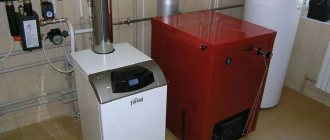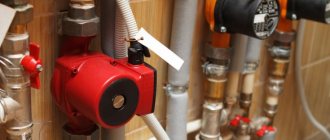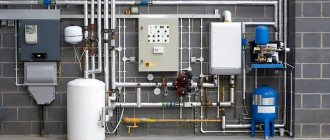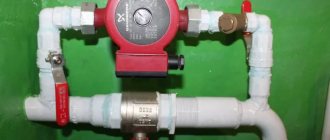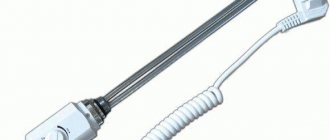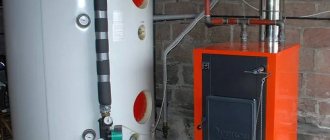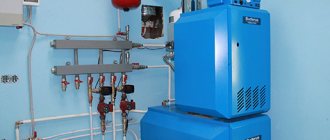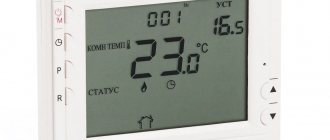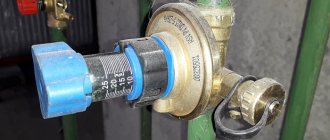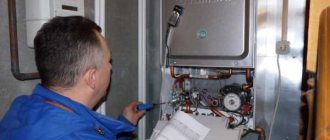When operating a heating boiler, it is necessary to control the pressure: too much can create an emergency situation, and too low will lead to a decrease in the efficiency of the heating. There are various methods of control. They include various types of automation, regulation of water flow into the boiler, control of the heating process of the coolant. The home owner must understand how the heating system works, how to properly regulate the pressure in it, and how the pressure sensor in the heating system works.
Sensors that monitor the operation of the boiler Source stroy-podskazka.ru
Why is it important to control your blood pressure?
For proper operation of the heating system, it is important that the pressure is within certain limits. Otherwise, the process of movement of the coolant through the pipes will be disrupted and the necessary heating of the room will not be provided.
In a heating boiler, the pressure level is related to how heating is carried out. Therefore, a temperature sensor is often used simultaneously with its sensor. If the pressure increases excessively, this can lead to an emergency. When it drops, the heat transfer process will be disrupted due to the slowdown in the movement of the coolant.
The use of an autonomous heating system helps citizens not to depend on a centralized system. This is useful where a private house does not have such an opportunity. Some owners choose this solution in order to save money.
If there are malfunctions, you need to contact a specialist Source priority-perm.rf
In both cases, it is important to achieve savings in fuel consumption. The pressure sensor saves money because it can be used to adjust the heating depending on the temperature and pressure in the boiler. It helps to turn on the pumps only when really needed. This saves energy for their operation and reduces equipment wear.
The sensors in question affect the quality of operation of the entire heating system. It is believed that the functionality of the heating boiler, pipes and radiators determines the efficiency of heating by 80%.
When the boiler functions as a hydraulic accumulator in a private house, water is pumped into it using pumps, which is necessary for consumption inside the house: for working in the kitchen, washing and other functions. If the pumps to ensure the supply of water operate continuously, the pressure in the boiler will increase, which can lead to damage to it or damage to elements of the home water supply network. If the pumping becomes weak, then the water from the tap will have little pressure.
Pressure sensors are connected to relays, which at the right times turn on or off the flow of water depending on the achieved pressure level. The timeliness of these actions ensures that the pressure in the boiler is maintained within the required limits. At the same time, the organization of the optimal mode of use of pumps is ensured.
Pressure sensor device Source crast.ru
Control methods
The state of the heating system can be partially controlled using temperature sensors. They are used to perform various functions. In particular, the pressure in a gas boiler depends on temperature. Using such sensors, you can evaluate the heating efficiency.
However, its use is not enough to regulate the operation of the heating boiler. In this case, the pressure sensor plays the main role. Failure to control the increase in pressure can lead to an accident. Therefore, the installation of such a sensor is necessary. If it is not included in the boiler design, then if there is forced circulation, the owner must install it additionally.
Industrial boiler for heating water Source temron.ru
Conclusions and useful video on the topic
The video below describes in detail how to install thermal devices on a heating boiler:
Is the installation of sensors on the supply and return pipes different?
Temperature sensors are widely used both in various industries and for domestic purposes. A large assortment of similar devices, which are based on different operating principles, allows you to choose the best option for solving a particular problem.
In houses and apartments, such devices are most often used to maintain a comfortable temperature in the premises, as well as to regulate heating systems - radiators, heated floors.
Do you have anything to add, or do you have questions about choosing and installing a temperature sensor?
You can leave comments on the publication, participate in discussions and share your own experience of using such devices. The contact form is located in the lower block. Date: September 25, 2022
What are pressure sensors used for?
Pressure is influenced by two factors: the flow of water into the boiler and its heating. The maximum permissible pressure should not exceed that which the boiler can withstand. It is desirable that it be less than the limit value by 0.5 atm or more.
The lower value is selected based on ensuring the required degree of heating in the house. In this case, it is necessary that the heating is not turned on too often. Usually in private houses the minimum value is 1.5 MPa and the maximum is 2.5 MPa. However, each time it is necessary to select individually. In this case, the optimal value can be in the range of up to 6 MPa.
Boiler pressure sensor Source teplo-plus.net
Sensors can have different types of designs. The simplest ones are mechanical or electrical. Some are designed to control a relay that closes or opens pipes.
Some varieties are equipped with pressure gauges so that a person can control the pressure level. A mechanism may be provided to prevent sudden changes in water.
It is important that the relay operation frequency is not too high. It depends on the volume of the hydraulic accumulator used in the pressure system and the number of devices consuming water at the moment.
Connecting a pressure sensor Source eteh.com.ua
For example, if in a private house they take a bath, do laundry and wash dishes at the same time, the relay will turn on the pump more often. This is due to higher water consumption than usual. Because of this, the pressure will begin to drop and the relay will operate. As a result, water pumping will begin. Due to the waste of water, the pressure will again drop to the lower limit and the relay will have to turn on the pump again. When the flow rate decreases to the normal value, the operating frequency will return to the normal value.
If the device is equipped with a pressure gauge, the owner can control the pressure level in the system. If it differs from the standard, it will be possible to understand the reasons for what is happening and take appropriate measures.
Heating boiler design Source teplo-teh.com
Features of control of heating boilers
When measuring pressure in heating boilers, two types of sensors are used:
- for steam;
- for water.
Such devices are usually called pressure switches. They have a more complex organization compared to conventional pressure sensors. The sensor readings determine the level of coolant pumping, the operation of fans to cool the boiler, and control the operation of the burners. Pressure switches can be designed to operate with a maximum pressure level, a minimum pressure level, or use a combined approach.
Sensors that monitor gas pressure are designed primarily to control the intensity of water heating. If the pressure is too high, the burners must work less intensely. If it is not enough, you need to heat the water better. When choosing relays for heating boilers, you need to ensure that they correspond to the features of specific models.
When the heating system is operating, the pressure in the system must be within certain limits. It should be such as to ensure normal coolant circulation. If the value goes beyond the limits, then as a result the movement of the coolant may stop.
Heating systems can provide for static or dynamic pressure changes. In the first case, the coolant moves naturally and without the use of pumping. In the second, a higher pressure must be provided at the inlet than at the outlet.
For the boiler to operate efficiently, it is necessary to correctly configure the pressure sensor Source oboiman.ru
Kinds
To classify temperature sensors, a special classification is used, which is based on a number of criteria. Among them:
- data acquisition algorithm;
- conditions and method of installation of the device;
- methodology for transmitting information.
Methodology for transmitting information
Based on the declared method of data transmission, sensors are divided into the following categories:
- wireless;
- wired.
To transmit information from the sensor to the control unit, outdated models are equipped with wires. Used for the operation of simple circuits. Such designs are gradually being replaced by wireless analogues. Such devices differ from others in their increased reliability and accuracy of transmitted readings. For maximum consistency in operation, it is recommended to use temperature sensors from the same company as the equipment being used.
Wireless designs are in high demand. To transmit data, modern transmitters are used, broadcast via radio waves. Such products can be used almost anywhere, including in open areas. Product features include:
- information transmission range;
- insignificant error in measurements;
- having its own battery (removable battery).
Data collection mechanism
Based on the installation method declared by the manufacturer, devices are divided into:
- alcohol;
- bimetallic.
In the second case, two plates are used, for the manufacture of which different materials and alloys are used. There is also a dial indicator. When heated, individual structural elements may become deformed, which leads to increased pressure on the pointer. The accuracy of such devices is high. The disadvantages include a high coefficient of inertia.
Both options are found in heating appliances, for example, central heating boilers. Such devices allow you to monitor the heating level of the device and help avoid consequences. Alcohol models, which are in demand among owners of private houses, are almost completely free of such shortcomings. The liquid is poured into a durable flask, which is sealed and becomes airtight. When heated, the solution expands. The operating principle is incredibly simple and at the same time convenient for subsequent monitoring.
Installation method and location
Based on the installation method, devices are divided into 4 categories:
- External. Located outside.
- Rooms. Can be used inside heated rooms.
- Submersible. While in active mode, they are in continuous contact with the coolant.
- Invoices. Attached to the heating circuit.
Modern technologies allow the simultaneous use of several types of sensors, which guarantee accuracy and continuous control over the temperature regime.
Principle of operation
Water pressure adjustment is carried out in accordance with the following algorithm:
- The taps open. After this, water from the boiler enters the heating system. At the same time, the coolant level decreases, and the pressure also decreases.
- The sensor monitors the pressure so that it does not become too weak. At the moment when the pressure reaches the threshold value, the relay contacts close.
- As a result, a pump is started that pumps water from a well or other external source.
- Due to the influx of water, the pressure will increase. The sensor will monitor when it reaches the maximum permissible value.
- At the moment when this happens, the relay is activated, causing the contacts to open. The pumps now stop working.
Boiler operation diagram Source teplo-klimat.com.ua
As a result, it is possible to maintain pressure within the specified limits. At the same time, it will not fall too much and will not rise so much that there is a risk of an emergency. The sensors not only regulate pressure, but also transmit its value to an external sensor so that the necessary information is available to the master. Periodically turning off the engine prevents it from running idle.
Malfunctions
High-temperature operating conditions of the sensors, especially during unstable boiler operating conditions, lead to the fact that the primary meters fail. The boiler will often shut down if the thermocouple fails periodically, or diagnostics of the boiler operation will signal an error, and the devices may show an “open circuit.”
Steps to troubleshoot a faulty temperature sensor:
- To repair the diesel engine, I check the correctness of the -ve and + ve conclusions
- I make sure that the cable is installed in accordance with the manufacturer's recommendations.
- I check that there are no external heat sources that could distort the DT readings.
- I check the temperature regulator setting.
- I diagnose possible interruption errors.
- I inspect the sensor for damage.
- I check the faulty thermocouple with a multimeter.
The temperature sensor is the main meter in the boiler safety and control system. It not only performs a protective function, but also contributes to up to 30% savings in thermal energy and gas consumption, since it does not allow overheating and boiler cycling.
Modern Russian requirements for the operation of household boilers oblige all boiler manufacturers to install diesel engines in the safety and protection system; it is better if this work is performed directly at the factory.
Mechanism of action
The main element of a mechanical sensor is an elastic membrane. On the one hand, it is affected by the liquid in the boiler. It bends, acting on structural elements that allow you to accurately determine the amount of pressure. When the threshold value is reached, the relay performs its intended action - closing or opening the contacts. The minimum and maximum thresholds are set using two springs of different diameters. As soon as the membrane presses on them, the corresponding action is performed.
A mechanical pressure sensor in a heating system can also have the following operating scheme. It is mounted so that water enters the cylindrical hole.
It will put pressure on the elastic membrane, which will bend under the influence of pressure. Behind the membrane there is a conductive metal disk, which will be displaced by a greater amount, the stronger the liquid acts on the membrane.
Sensors must be easily accessible Source sovet-ingenera.com
There are protruding parts along the edges of the disk. When the disk advances, the contacts are closed. This will turn on the relay. If the pressure decreases, the curvature of the membrane will decrease and the disk will open the circuit. As a result, the relay will turn off.
In this way, the pumps will be turned on or off depending on the presence of a certain pressure in the boiler. The disk may have two pairs of protrusions of different sizes. Depending on the degree of exposure to water, the connection of different contacts will occur at different pressure values.
The electrical sensor uses a different operating principle. Here the main element is still the membrane, but its deformation is converted into an electrical analog signal. Next, it is strengthened to the desired level. Then it is converted into a discrete form. It is supplied to the control unit, which, depending on its value, supplies the corresponding control signal intended to close or open the contacts.
There are also electromechanical devices. They must include a pressure gauge. However, it uses three arrows. Two of them indicate the minimum and maximum pressure values, and one indicates its current value. When the parameter reaches a critical value, the circuit closes and, as a result, a command is given using a relay to turn the pumps on or off.
Heating system in a private house Source aqua-rmnt.com
Typically the membrane is located inside a tube of circular or elliptical cross-section. It shifts from the pressure in the boiler and affects the pressure gauge readings and the operation of the relay. When choosing mechanical sensors, the following requirements must be taken into account:
- It is important to consider measurement error. It should not be so large that it distorts the results.
- When choosing a household pressure gauge, the accuracy class should not be lower than 2.5.
- It must be remembered that the sensor is used in intensive mode. As a result of prolonged use, the instrument's readings may become less accurate.
It is recommended to calibrate the sensor before the start of each heating season.
The advantages of mechanical type sensors are affordable cost and higher reliability. Electric ones provide better functionality. For example, here you can organize a connection after an emergency shutdown has occurred. Some models provide transmission of signals to the owner's mobile phone.
Pressure sensor with a relief valve Source otivent.com
It should be borne in mind that there are other types of sensors under consideration, but they are relatively rare. An example is liquid devices. This scheme uses the principle of communicating vessels. In this case, the liquid inside the boiler is discharged outside into a vertical transparent tube.
Depending on the height to which it rises, one can judge the amount of pressure. This method is highly accurate, but it is usually used only in laboratory conditions.
Differential type devices are also used. Here, two cameras are used for measurement, the connection between which is made in the form of a sensitive element. Typically, such measuring instruments are used as remote ones.
Multifunctional electronic boiler pressure and temperature control system Source owen.ru
Purpose of measuring instruments
Pressure and temperature sensor in one housing
What do any type of heating have in common? This is a periodic change in the temperature of the coolant and, as a result, its pressure. To monitor the degree of expansion of water, pressure sensors are needed in the heating system. With their help, you can observe current data and, if they deviate from the norm, take appropriate measures.
Temperature sensors for heating have a wider range of applications. In addition to visually displaying the degree of heating of the coolant in individual areas of the system, they can record indoor or outdoor air temperature data. Taken together, the two types of devices should form an effective tool for monitoring, and in some cases, automatic stabilization of heating system parameters.
How to choose the optimal water pressure sensor in the heating system or thermometer? The main criteria are the system parameters. Based on this, the following requirements are imposed on measuring instruments:
- Measuring range . Not only the accuracy, but also the relevance of the information depends on this. Thus, a temperature sensor in a heating system with an incorrectly selected upper limit will show biased data or fail;
- Connection method . If you need to know the heating level of the coolant with high accuracy, you should choose immersion thermometer models. A classic pressure sensor for heating can only be mounted directly into the heating main of the house, boiler or radiators;
- Method of measurement . The method of taking readings affects the inertia of the device - the delay in displaying actual data. It also determines the appearance and visualization of parameters - arrow or digital.
In an open system, the pressure parameter is not important, since it is almost always equal to atmospheric pressure. However, heating temperature sensors are installed in any circuit - gravitational, with forced circulation or when connected to a central network.
To easily monitor the system readings, you can purchase a device that combines a pressure and temperature sensor. Despite the relatively high cost, it is much more convenient to take current data on the state of the heating.
Installation location
When water enters the boiler, filter elements are located after the tap. The pressure sensor is usually mounted between them. This is due to the fact that pressure surges occur less frequently in this location. When installing, you must take into account the operating requirements specified in the instructions. For example, some types of relays can only be used indoors. Tees are used for connection. They make it possible to connect not only a sensor to the boiler, but also a pressure gauge.
The connection location is selected depending on the technical features of the device. In some cases, it is more advisable to install the relay directly on the water pump in the well. In this case, they must be placed in a moisture-proof housing. To install an electrical type sensor, you will need to connect an electrical cable for power.
Its thickness must correspond to the power of the pumping equipment. For example, if it is 2 kW, then the cable cross-section should not be more than 2 square meters. mm. After completing the connection, you need to check the functionality of the structure. To do this, turn on the pump and check the pressure. If the installation was carried out correctly, then it should increase.
Heating system in a private house Source project-home.ru
Temperature standards
Requirements for the temperature of the coolant are set out in documents that specify the standards that establish the design, installation and use of engineering systems of residential and public buildings. They are described in the State Construction Standards and Rules:
- DBN (V. 2.5-39 Heating networks);
- SNiP 2.04.05 “Heat supply, ventilation and air conditioning system.”
For the calculated supply water temperature, the figure that is equal to the temperature of the water leaving the boiler, according to its passport details, is accepted.
For autonomous heating, it is necessary to decide what the temperature of the coolant should be, taking into account the following factors:
- Beginning and ending of the heating season based on the daily average outdoor temperature of +8 °C for 3 days;
- The average temperature inside heated residential and public buildings should be 20 °C, and for industrial buildings 16 °C;
- The average design temperature must comply with the requirements of DBN V.2.2-10, DBN V.2.2.-4, DSanPiN 5.5.2.008, SP No. 3231-85.
According to SNiP 2.04.05 “Heat supply, ventilation and air conditioning system” (clause 3.20), the limit values of the coolant are as follows:
- For a clinic - 85 °C (excluding psychiatric and drug departments, as well as administrative or home use premises);
- For residential, public, and also domestic buildings (not counting halls for sports, trade, spectators and passengers) - 90 ° C;
- For auditoriums, restaurants and premises for production of categories No and B – 105 °C;
- For catering companies (excluding restaurants) it is 115 °C;
- For production premises (categories B, D and D), where flammable dust and aerosols are emitted – 130 °C;
- For staircases, lobbies, pedestrian crossings, technical premises, residential buildings, industrial premises without the presence of flammable dust and aerosols – 150 °C.
Depending on external factors, the water temperature in the heating system can be from 30 to 90 °C. When heated above 90 °C, dust and varnish begin to decompose. For these reasons, sanitary standards prohibit greater heating.
To calculate good indicators, specialized graphs and tables can be used, which set standards depending on the season:
- With an average reading outside the window of 0 °C, the supply for heating devices with different wiring is set at 40 to 45 °C, and the return temperature at 35 to 38 °C;
- At -20 °C, the supply is heated from 67 to 77 °C, and the return rate should be from 53 to 55 °C;
- At -40 °C outside the window, absolutely all heating systems are set to the maximum possible values. On the supply side it is from 95 to 105 °C, and on the return side it is 70 °C.
Adjusting parameters
When purchasing a sensor, the owner can proceed in various ways. It can leave the factory settings. This makes sense in cases where the pump operates under standard conditions.
If the design used has its own characteristics, then it is better to configure it yourself. How to do this is described in detail below.
After installation, it is necessary to adjust the minimum and maximum pressure values. It is important that the difference between them is approximately 1 atm. Before making adjustments, perform the following steps:
- All pump elements are disconnected from the network. Now you need to completely drain the water from the pump.
- You need to check the pressure level in the boiler. To do this, you can use any available pressure gauge.
- It is necessary that the pressure be equal to 1.5 atm. If it is less, you need to pump up water.
- If it is exceeded, you need to lower it by pressing the nipple.
Electronic pressure switch Source kty.com.ua
After the boiler has been prepared, it is necessary to begin the adjustment procedure. Here, as an example, we consider a mechanical type sensor. The adjustment is carried out as follows:
- To begin the adjustment procedure. The pump must be turned off. Then drain the water completely. Check the pressure gauge readings. It should show zero value.
- Start filling the boiler with water. When the process is completed, it is necessary to measure the pressure again. This value must be fixed.
- Now you need to drain the water to get the minimum pressure value. It is also fixed.
- Using a nut, the springs are approximately adjusted so that they correspond to the desired value. Weaken a spring with a smaller diameter. Using a nut, the compression of a larger diameter spring is adjusted. It must be remembered that when tightening it increases the minimum response pressure, and when unscrewing it decreases it.
- Fill the system with water, then drain it. It is necessary to determine the moment when the pump will automatically turn on. If it is more or less than required, additional adjustment of the spring is carried out.
- Start adjusting the spring with a smaller diameter. It is tightened to set the value at which the pump will turn off. Compression will lead to a decrease in the difference between the maximum and minimum pressure values, and weakening will lead to an increase in this parameter.
- Check the set values. To do this, start the pump and determine at what pressure value the shutdown will occur.
- If the maximum value is not set accurately, then by tightening or unscrewing the nut, adjust the degree of compression of a small diameter spring until the parameter is set accurately.
When the pressure thresholds are accurately set, the adjustment procedure is completed.
Gas boiler pressure switch Source stroy-podskazka.ru
Underfloor heating thermostats
Warm floors are convenient and comfortable, and this heating method is becoming increasingly popular. Despite the different types of heating, electric and water heated floors are controlled by similar devices. The internal mechanics of the changes are different, but the types and types of thermostats are the same.
Types and device
Based on the method of setting controlled parameters and functionality, these devices are divided into:
- Mechanical. The required temperature is set by turning the dial with marks on it. The models are the simplest and most inexpensive, but also the most reliable. True, without any additional features.
- Electronic. The functionality is the same, only the principle of setting the temperature has been changed - using buttons. There is also a digital display that shows current and set temperatures.
- Programmable thermostats or programmers. The principle of setting parameters is the same - buttons, but there are more functions: it is possible to set the temperature by time of day or day of the week. May have portable control panels.
- Touch programmers. Similar to the programmers described above, only touch buttons are used.
All of these devices transmit commands using wires, which makes their installation difficult and painstaking. But there are systems that transmit signals using radio transmitters. These are also programmers, but with even wider functionality: some of them can be controlled via SMS, others - from a computer and tablet.
Sensors for floor heating thermostats
Temperature adjustment can be carried out according to the degree of floor heating, or according to air conditions. There are models that have both types of control. Then the main parameter is the air condition, and floor control is secondary. Such thermostats have two sensors: floor temperature (remote) and air temperature (built into the housing).
Some thermostat models can control both floor temperature and room temperature
When is it best to use which type of sensor? It is advisable to monitor the air condition if the heated floor is the only heating system. After all, its temperature is then the main indicator. If underfloor heating only serves to increase comfort, it is better to monitor the temperature under your feet. In this case, it is the main criterion.
If the air is controlled, no additional sensors are needed: they are usually built into the thermostat housing. To monitor the degree of heating of the floor, you need to install a special sensor in the screed or under the floor covering, which is connected with wires to certain contacts on the thermostat body.
Principle of operation
The operating algorithm is, in principle, no different. When the temperature rises by one degree, the room thermostat of the electric heated floor turns off the power to the heating elements. In the case of water heating, the coolant supply is closed. The system remains in this position until the temperature drops 1oC below the set value. Then the coolant/power supply is restored. This is how the heating temperature is automatically adjusted with an accuracy of one degree.
Adjusting the radiator temperature will not raise it
And yet, although the operation of the devices is similar, there are differences. Read more about water floor regulators here, and this article describes electric floor thermostats, their features and installation.
Selecting a sensor when purchasing
It is important to clarify for what operating pressure range it is intended. This data can be found in the technical data sheet of the device. If the range is not sufficient for this boiler, then it is better to look for another sensor model.
In this case, it is necessary to provide for a gap of 0.5 atmospheres. By this value, the limit value with which the sensor can operate must certainly exceed the maximum permissible value for the accumulator.
In most cases, a measuring range from 0 to 4 bar is sufficient for home pressure gauges. If we are talking about industrial use, then we can talk about higher pressure.
Various models of pressure sensors Source thermoexpert.ru
It is necessary to take into account the diameter of the fitting for fastening. Previously, most of these devices had a diameter of 0.25 inches. Now the production of devices with 0.5-inch fittings has increased.
It is important that the pressure gauge is installed in such a place that it is easily accessible. The pressure sensor must be suitable for the operating conditions. For example, some applications may require pressure gauges designed to operate in high or low temperature environments.
Each measuring device has a specified testing frequency. It is advisable to choose a model so that monitoring of correct operation is required less frequently.
Connecting a pressure sensor Source stroyfora.ru
Depending on the principle of operation of the device, its characteristics will differ. The most common sensors are those that use springs. This is due to the fact that they provide acceptable accuracy, but are affordable. Membrane devices provide higher accuracy, but also cost more. Electrical devices provide high-quality control, but are much more expensive, so they are rarely used in private homes.
It must be taken into account that the number and location of sensors should be determined by the boiler usage pattern. In some cases, you can limit yourself to installing one instance, and sometimes you may need more. In simple cases, if the boiler is used as a simple source of water raised to the desired height, then you can simply pump water by turning the pump on and off manually.
If we are talking about a heating boiler, then monitoring the pressure in the boiler is vital. Uncontrolled heating of the coolant will lead to an emergency. In such cases, an automated control system for heating and pump operation is created. This is especially important if there are two or three heating circuits.
When defining parameters, different units of measurement are used. In order to navigate them well, you need to know how to determine the relationship between them. 1 bar is equal to 0.99 atmospheres. When giving figures using megapascals, it must be taken into account that there are 10 bar in 1 megapascal.
Correct adjustment of sensor parameters is necessary for uninterrupted operation Source strojdvor.ru
Sudden drop in pressure
When measuring pressure in the heating system, the owner may encounter emergency situations. One of the most common is sudden changes in pressure. In these situations, automatic adjustment will not be enough. It is necessary not only to find out that a difference has occurred, but also to determine its cause. The most common are the following:
- There is a malfunction of the pumps used. The automatic adjustment system is built on the basis that they work normally, but in an emergency an unpredictable situation will actually arise.
- The appearance of a leak in the accumulator. It will provide a constant decrease in pressure, which will lead to constant operation of water pumps or to heating of the heating boiler above a critical level.
- Random failure of the settings used by the pressure sensor.
- Damage to the boiler shell. For example, microcracks may form. This dramatically reduces the strength of the equipment and increases the risk of an emergency.
- If direct control is carried out via an electronic board, then its failure is possible. In this case, for repairs you will need to contact specialists or replace with a new one.
- A sudden shutdown of heating or pumps may occur, after which the switching on does not occur for a long time. This is usually due to a malfunction of the relay.
- For the equipment to function properly, it is important that the power supply meets the required parameters. Electrical devices may malfunction due to power surges or sudden shutdowns.
These reasons are the most likely, but other options are also possible. If pressure surges are detected, the following should be done to analyze the situation:
- First you need to make sure that all connections are tight.
- It is necessary to carefully visually inspect all elements of the structure one by one and make sure there is no damage.
- If you shut off the valves one by one and monitor this using the pressure gauge readings, you will be able to determine the expected location of the malfunction.
If an unreliable connection is detected, it must be sealed and then tightened. If repair cannot be achieved, the problematic parts must be replaced. If microcracks are detected, installation of a new unit is mandatory.
Sometimes problems with pressure regulation are associated with a broken or malfunctioning sensor. Often in this situation the cause is due to damage to the membrane. During inspection, it is necessary to check the power supply connection.
The water pressure in the system must comply with the standards Source sovet-ingenera.com
Strong increase in pressure
Unnecessarily high pressure increases the risk of an emergency. The most likely reasons for this situation are:
- Random formation of air pockets in pipes.
- During operation, gradual contamination of pipes and filters occurs. They need to be cleaned regularly and replaced if necessary. If this is not done on time, it leads to increased pressure.
- In case of a malfunction of the pressure regulator.
- The pumps are not switched off regardless of the relay signals.
- In case of complete shut-off valve closure.
If the cause of the problem is an air lock, then you must first bleed the water and then begin normal operation of the system.
If the filters are dirty, they need to be cleaned. Pipes will function normally only if they are cleaned regularly. Sometimes it is impossible to remove contaminants in pipes. In this case, it will be necessary to replace the corresponding section of the system.
Hydraulic accumulator for water supply systems Source art-liga.rf
If, after diagnosing the system, it becomes clear that the cause of the problem is the regulator, then you need to check the correctness of its settings. If necessary, it is necessary to re-calibrate and set the parameters.
The occurrence of problems with the power supply may, for example, be associated with power outages or sudden surges. In this case, care must be taken to install appropriate devices to ensure uninterrupted power supply.
When the regulator is controlled by an electronic board, sudden voltage surges can damage it. It is necessary to check the functionality of the device and, if necessary, replace it.
In some cases, an increase in pressure occurs due to the complete closure of shut-off valves. If a problem situation arises, you need to check the condition and, if necessary, open them.


